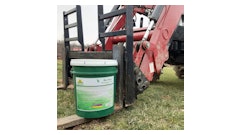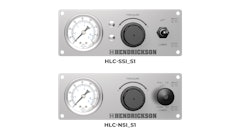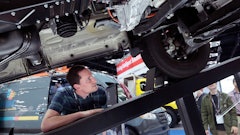
Ethanol is a useful tool to reduce the consumption of foreign oil, and has proven to be safe for most engines in blends up to 10% (designated as E10). But the government has recently made a push to increase the ethanol content in gasoline.
E15, which is a blend of 15% ethanol and 85% gasoline, will soon be coming to a gas station near you, if it hasn’t already. The Environmental Protection Agency (EPA) contends E15 is compatible with cars newer than the 2001 model year and is a valuable alternative fuel source, although some automobile manufacturers state that E15 does not comply with fuel requirements specified in their owner’s manuals.
But the major objection with E15 is with the way the fuel is being distributed. Organizations such as the Outdoor Power Equipment Institute (OPEI) contend that adequate measures are not in place to prevent misfueling and point out that there is the continued need for fuel with 10% or less ethanol, since small non-road engines are not designed or warranted for fuel above E10. (See “Beware of E15” at ForConstructionPros.com/10362939.)
Video: Be Sure to Use E10 or Lower Ethanol-Gasoline Blends
No one denies the compatibility issues between E15 and non-road engines. In fact, following the EPA and Department of Energy (DOE) testing in outdoor power equipment and other non-road products, it was determined E15 is not suitable for any non-road use.
Organizations filed lawsuits to address the potential misfueling concerns, and there are still efforts under way in the courts and in Congress by engine makers and product manufacturers to stop the introduction of mid-level ethanol fuels. But as of this writing, a single warning sticker on the pump will alert customers that the fuel is not suitable for use in certain engines.
More Alcohol Damages Engines
E15 has raised many red flags since the initial waiver was granted on July 25, 2011. “This fuel is universally opposed by our entire industry because of the problems it causes,” says Brad Murphy, Subaru Industrial Power Products.
While a 5% increase in alcohol content may seem pretty minor to most of us, the reality is it significantly changes the properties of the fuel. Keep in mind this is actually a 50% increase in alcohol from the current E10 fuel.
“Research has shown that using E15 can have harmful and costly consequences on small engines and outdoor power equipment,” says Murphy. “Most engines would have great difficulty in meeting both emissions and performance expectations with this type of alcohol range.”
The effects of E15 can’t be categorized as isolated. “In fact, DOE testing showed that seven out of the 11 engines tested behaved ‘poorly’ or ‘erratically’ with the fuel,” says Murphy. “The EPA acknowledges these results, despite the fact that its overall position is increasing ethanol content in gasoline is desirable.”
Briggs & Stratton Corp. has conducted its own extensive testing on levels of ethanol above 10%. “Increasing the levels of ethanol in gasoline results in increased levels of alcohol,” says Laura Timm, vice president of corporate communications and public affairs at Briggs & Stratton. “Alcohol has inherent properties that cause issues with our engines and they become more acute with increasing alcohol content. Increasing the alcohol in fuel changes the air-fuel ratio (enleanment) in our carbureted engines.”
This makes it very difficult for the engines to meet both emissions and performance expectations. “Enleanment will also result in higher operating temperatures that will lower engine life due to issues such as valve sealing, piston scoring and head gasket leaking, just to name a few,” Timm notes.
An interesting dilemma is that you can’t be guaranteed of the exact percentage of gasoline vs. alcohol. “Most gas stations have tanks where the supplier puts the mixed gasoline into the storage tank and the pump pumps it up. Because alcohol separates from gasoline, consumers can get a higher mix of alcohol in their fuel,” Murphy explains. “If you increase to 15%, the effect gets multiplied, so you might end up with double the alcohol that you expected. That’s a problem.
“We know that increased alcohol levels in the fuel cause damage to a small, air-cooled engine’s carburetor,” he continues. “Because alcohol has corrosive properties, you can get a breakdown of the zinc plating inside a carburetor, where the fuel sits, even if you have a corrosion-resistant carburetor.”
Ethanol Attracts Water
Another problem is that alcohol attracts water. “If you let this type of fuel sit in the tank, the water will sink to the bottom,” says Murphy. “Combine this with the corrosive effect of alcohol, and you will get rusting of metal parts. It also attacks the aluminum used in every manufacturer’s carburetors, and causes corrosion that can lead to engines that run poorly or not at all. Equipment owners are likely to find a great deal of corrosion to the carburetor bowl, as well as a gumming up of the main jet.”
“Increased levels of water will cause corrosion by means of acid attach, galvanic activity and chemical interaction,” says Timm. “Ethanol will also cause other problems, such as reduced fuel storage life, starting issues and reduced fuel economy. These problems are very widespread.”
Engines run hotter and there is less lubrication. “Internal parts like exhaust valve seats, pistons and top rings are forced to handle the extra heat, which ends up shortening the life of the engine,” says Murphy.
Not all engines will be impacted the same. “E15 is especially bad for two-stroke engines, where you mix the oil in the gasoline to lubricate the inner workings of the engine,” says Murphy. “Because alcohol is a solvent, it cleans oil from the internal metal parts. Therefore, you have metal on metal moving at very high speeds, creating high heat and causing extreme wear. Running high-alcohol fuel can destroy a two-stroke engine in only a couple of minutes.
“On premium four-stroke engines like Subaru engines, it’s not as big of a problem,” he adds. “Most of the problems we see are caused by corrosion from water that collects in the alcohol and is left sitting in the carburetor bowl for months at a time. Our engines can handle E15 if the consumer doesn’t store it or leave it in the tank for more than 30 days. Stabilizers are helpful, but they don’t fully eliminate the problem. With that said, we specify using only E10 fuel in our products.”
If in doubt about the fuel your engine should use, check the owner’s manual. “Briggs & Stratton engines are certified and warranted to run on gasoline with up to 10% ethanol,” says Timm. “Use of any fuel with more than 10% ethanol will void the warranty.”
Pay Close Attention to What You Put in the Tank
The way E15 is being distributed breaks precedence. “When unleaded fuel was introduced, the nozzle on the pump for unleaded gasoline was a different size that matched inlet holes on cars meant to take that fuel, so it physically was difficult to put the wrong fuel in your tank,” says Murphy. “On E15, there is no such isolation other than labeling on the pump.”
It is now up to you to read the gas pump label and ensure the fuel you use in non-road products contains no more than 10% ethanol. It’s no longer safe to assume that if you can burn it in your car, you can also use it in small gas-powered engines.
“We’ve already seen issues with people putting E85 in small engines, either because they didn’t know or because it was cheaper,” says Murphy. “Small engines don’t have the sophisticated electronic fuel controls on them like a car does, so they can’t compensate for the higher heat, lack of lubrication and the corrosive effect the alcohol has on them.”
If a customer doesn’t understand that the equipment is not compatible with E15, or buys strictly on price without reading the labels, there is a good chance of placing E15 in incompatible engines. This will void the warranty. Any fuel-related damage becomes the owner’s responsibility.
“Studies have strongly suggested that the rate of misfueling at the pumps will be significant,” says Timm. “Consumers have long enjoyed the ability to fuel multiple products from one pump (car, boat jerry can, etc.). That will no longer be the case and they will be forced to buy two different fuels for a variety of products — if their gas station carries it. There is currently no plan in place to continue to carry legacy fuel (up to E10) for legacy products.”
In other words, a gas retailer could decide there is not enough volume to justify carrying E10 and switch completely to E15. While it seems unlikely, there is no legislation to prevent this from happening.
“Briggs & Stratton estimates there are approximately 80 million households that currently have our products, and having fuel containing E10 or less is critical to those consumers,” Timm states.
Retrofitting previous engines to run on E15 is really not an option. “There are huge numbers of engines on everything from generators to string trimmers designed for alcohol up to E10 right now,” says Murphy. “Equipment manufacturers do not recommend using E15 on current or older equipment. There are likely going to be millions of damaged engines caused by misfueling... whether for snowmobiles, motorcycles, generators or lawn equipment. This could easily be blamed on the consumer, but the fuel was introduced with no education to the public.”
Oops, Now what?
Misfueling is bound to occur. It even rarely happens with diesel and gasoline. When it does, it’s important to act quickly. Don’t set the equipment aside to be dealt with later.
“Drain the fuel system out,” Murphy advises. “After 30 days, it starts turning into a gummy mess and begins corroding the bottom of the carburetor. If gas is left in the fuel tank long enough, it will evaporate in the small bowl of the carburetor. The gum and water from that fuel will all be concentrated in one tiny area that holds about a teaspoon of fuel in the bowl.”
Timm agrees, noting, “It is illegal to use E15 in any of our products, but if misfueling does occur, the fuel should be drained immediately. Consumers should consider using a fuel additive to combat any effects from the ethanol, such as Briggs & Stratton’s advanced fuel treatment. The longer these blended fuels sit in the tank, the more damage they can do, resulting in starting issues, rough running and severe engine damage.”
Above all, you really need to be vigilant to ensure E15 doesn’t find its way into your small outdoor engines. “Unfortunately, the damage to a variety of products will be irreversible,” says Murphy.






























